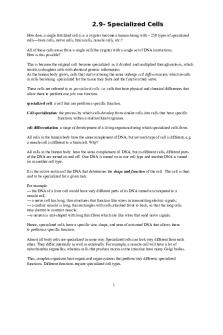Auxiliary Cells PDF

| Title | Auxiliary Cells |
|---|---|
| Author | lilly binks |
| Course | Applied Biomechanics |
| Institution | University of Central Lancashire |
| Pages | 1 |
| File Size | 35.3 KB |
| File Type | |
| Total Downloads | 95 |
| Total Views | 169 |
Summary
assesment on auxiliry cells...
Description
Auxiliary Cells Often Described as the body’s terrorist cells as it contains 3-5 members, and the cells don’t recognise each other or the identity of their leadership. They have a spore-like structure. Auxiliary cells mediate inflammation as part of the immune response. The 3 main types of auxiliary cells involved in the immune response are: Basophils, Mast cells and Platelets. Basophils are also a type of leukocyte, it contains granules that when they degranulate release histamine and factors to activate platelets. Mast Cells also contain granules which are released when the cell is triggered and cause the tissue around to become inflamed An immune response activates platelets
A leucocyte is a colourless white blood cell. It circulates in blood and bodily fluids. Its function is to counteract foreign substances and disease. All white blood cells start in bone marrow as stem cells. Leukocytes are divided into three types: Granulocytes – these make up 50% - 60% of all leukocytes. They are split into 3 classes: neutrophils, eosinophils and basophils. Lymphocyte – make up 30% -40% of all leukocytes. Lymphocytes come in 2 classes: B cells, which mature in bone marrow and T-cells which mature in the thymus. Monocyte – monocytes make up about 7% of all leukocytes...
Similar Free PDFs

Auxiliary Cells
- 1 Pages

Auxiliary Views
- 6 Pages

Auxiliary Verbs notes
- 1 Pages

Marine Auxiliary Machinery.pdf
- 525 Pages

Stem cells
- 1 Pages

ANHB1101 Cells
- 4 Pages

Stem Cells
- 1 Pages

Chapter 5- Cells
- 7 Pages

Experiment- Galvanic Cells
- 4 Pages

INTRODUCTION TO CELLS
- 16 Pages

White Blood Cells Abnormalities
- 5 Pages

Blood cells 1 - ghghg
- 1 Pages
Popular Institutions
- Tinajero National High School - Annex
- Politeknik Caltex Riau
- Yokohama City University
- SGT University
- University of Al-Qadisiyah
- Divine Word College of Vigan
- Techniek College Rotterdam
- Universidade de Santiago
- Universiti Teknologi MARA Cawangan Johor Kampus Pasir Gudang
- Poltekkes Kemenkes Yogyakarta
- Baguio City National High School
- Colegio san marcos
- preparatoria uno
- Centro de Bachillerato Tecnológico Industrial y de Servicios No. 107
- Dalian Maritime University
- Quang Trung Secondary School
- Colegio Tecnológico en Informática
- Corporación Regional de Educación Superior
- Grupo CEDVA
- Dar Al Uloom University
- Centro de Estudios Preuniversitarios de la Universidad Nacional de Ingeniería
- 上智大学
- Aakash International School, Nuna Majara
- San Felipe Neri Catholic School
- Kang Chiao International School - New Taipei City
- Misamis Occidental National High School
- Institución Educativa Escuela Normal Juan Ladrilleros
- Kolehiyo ng Pantukan
- Batanes State College
- Instituto Continental
- Sekolah Menengah Kejuruan Kesehatan Kaltara (Tarakan)
- Colegio de La Inmaculada Concepcion - Cebu



